John Wayne in Colorado

Duke Morrison's very first movie location was Glendwood Springs, Colorado. In 1926, young John Wayne was invited to come along and help Tom Mix stay in shape during the filming of The Great K&A Train Robbery. The former USC student turned movie star had come a long way when he returned to Colorado in 1969 to do his oscar-winning True Grit. This picture shows the entrance to the "Ross homestead" as it is today. Located on Last Dollar Road, off Highway 62, on the road from Ridgway to Telluride.

The finale of True Grit took place on top of the hill overlooking the farmhouses at Lost Dollar Road. They had the first part of the sequence in the can but it snowed that night, so director Henry Hathaway decided to re-shoot the whole scene. This photo of John Wayne on Dollor was taken during the first day without snow.

"Come see a fat old man sometime": The place where Rooster Cogburn jumped the fence. The location of McAlester's Store can be found closeby. To find this John Wayne movie location, follow Highway 62 further up, take the cutoff that leads to the area called Horsefly Mesa.
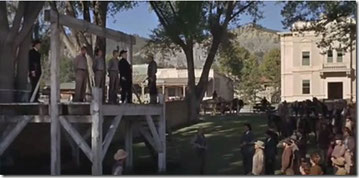
The gallows for John Wayne's True Grit was built in Hartwell Park in the middle of Ridgway, located on scenic U.S. Route 550 and coined "Gateway to the San Juans". The Paramount crew constructed the shell of Judge Parker’s courthouse from which the “Hanging Judge” supervises the execution on Lena Street.
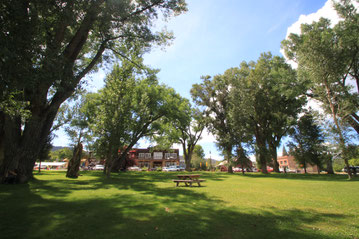
Director Henry Hathaway had used the town of Ridgway before he came back to direct John Wayne in True Grit. Hatwell Park in the middle of town is where Gregory Peck offers his services to Debbie Reynolds and Thelma Ritter in How the West Was Won.

After Rooster Cogburn (John Wayne in his award-winning performance) delivers his prisoners in a caged wagon, he walks downstairs to take a side entrance. In 1985, the True Grit Café was built on this empty lot.
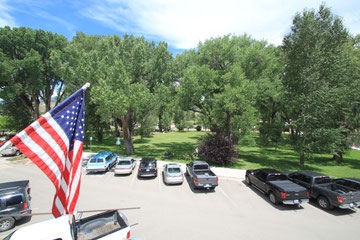
View from the terrace of the True Grit Café on the spot where Rooster Coburn (John Wayne) made his entrance in True Grit. The establishment honors the movie and its star.

The True Grit Café actually encloses the original movie location of John Wayne's entrance as Rooster Cogburn: The external wall on which the art department painted “Chambers Grocery” is now the internal south wall of the restaurant.

Rooster Cogburn's paddy wagon (seen here during renovation in 2017) is usually parked in its place of honor downtown. John Wayne runs this cage on wheels into his first scene in True Grit.
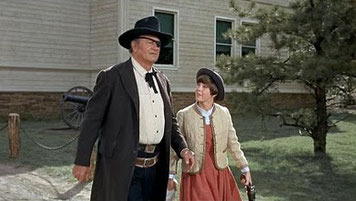
John Wayne leads Kim Darby down Clinton Street in Ridgway in this scene in True Grit: To the left of Clinton Street is the lot where Cheng Lee’s shop was.

On the corner of North Lena and Clinton in Ridgway, Colorado, the Old Ridgway Fire Station bell tower was added for the John Wayne movie True Grit (originally a high school building).
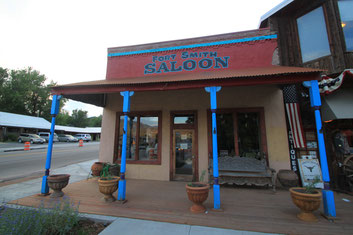
In the very beginning of John Wayne's Oscar winning film True Grit, Mattie’s father gets shot down on Lena Street in Ridgway, in front of the “Fort Smith Saloon”. What used to be a movie saloon is now the place of an Adventure Sports store.

The old stone house at Clinton Street in Ridgway – that’s where John Wayne's frequent co-star Hank Worden acted as an embalmer in True Grit.
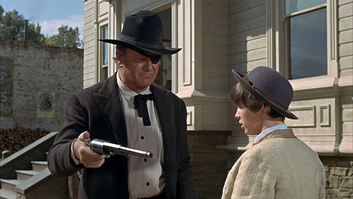
The courtroom scenes in True Grit were merged: John Wayne's outdoor shots of the shell built for the movie in Ridgway on Lena Street cut to...

...the real courthouse in Ouray, ten miles from Ridgway. The time-honored county courthouse stands on 4th Street. The scene on the stair with John Wayne and Kim Darby rolling Rooster's cigarette, as well as the courtroom sequence were shot inside the courthouse.
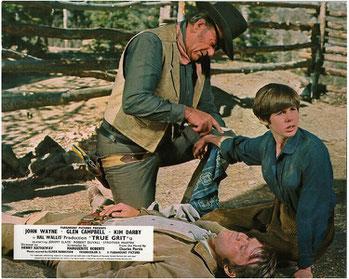
The True Grit art department built the snakpit - where John Wayne saves Kim Darby - in the Ouray area, where Million Dollar Highway cuts to the right onto Camp Bird Road. The remains of the pit are on private property.

Several True Grit locations can be found along the Owl Creek Pass. With Chimeny Rock rising above Deb’s Meadow, near the summit, this was the perfect place for Rooster Cogburn's (John Wayne) showdown with Lucky Ned Pepper (Robert Duvall).

John Wayne is trapped under the fallen horse. When Rooster Cogburn's horse got shot, it went down...
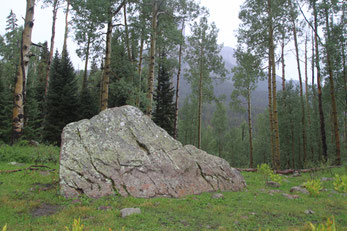
...right here, in front of this boulder on Deb's Meadow. Again, Henry Hathaway had used that location around 5 years before True Grit, in the epic How the West Was Won, in a scene with Gregory Peck and Debbie Reynolds. Some people say that's how the meadow got its name.
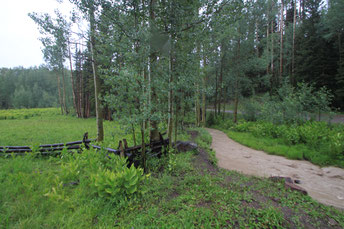
Also on Deb's Meadow, even though it's right next to the shootout location: you'll find the place where John Wayne (Rooster Cogburn) made camp and the Texas Ranger (Glen Campbell) shot the turkey.
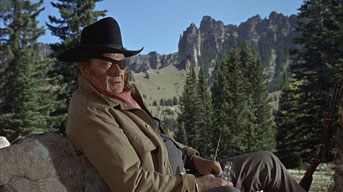
Follow the road to the summit until you reach a loop and you will find this True Grit movie location, the place of the last camp. This is...
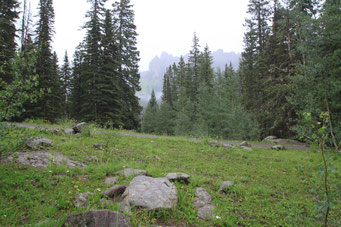
...Cimarron Range in the background of the scene where Rooster (John Wayne) hits the bottle a little too hard and Mattie...
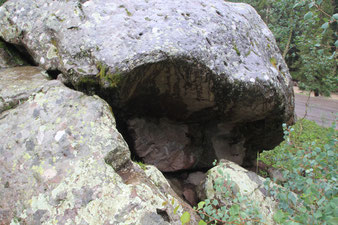
...Kim Darby goes to sleep under this rock which the locals now call the "Sleeping Rock" of True Grit.
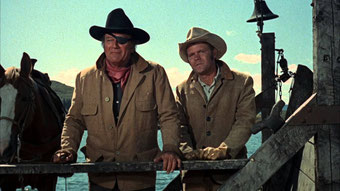
The Blue Mesa Reservoir east of Montrose on Highway 50 was the True Grit location of the ferry sequence, when John Wayne remarks "She reminds me of me!" The water was much lower then; this location is now underwater.

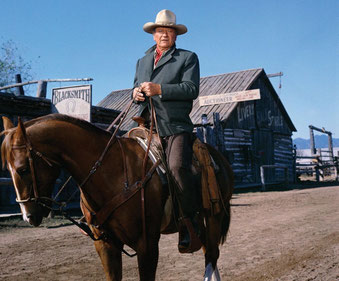
The movie town known to moviemakers and tourists alike was Bucksin Joe. That's John Wayne as Wil Anderson going to town in The Cowboys. MGM built it in 1957, eight miles west of Canon City, Colorado. Its most important characteristic was that it was formed with around thirty authentic, 100-year-old log buildings from the Colorado frontier, assembled there into an old western-style town. The owners developed the location into a theme park. That all ended in 2010 when Bucksin Joe was sold. A billionaire purchased it as a whole. All that was left were the original entrance boundary stones and a couple of unwanted wooden planks, left in the grass (see picture above). The town was moved to his ranch near Gunnison. Ironically, Gunnison was used as a location in The Searchers.

That's the Durango-Silverton Narrow Gauge Railroad you see in the title sequence of the John Wayne western The Sons of Katie Elder, steaming up the forty-five miles of track between Durango, Colorado, and Silverton...
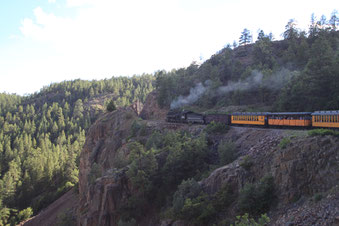
...and even though John Wayne himself didn't ride in the Durango-Silverton Railroad, the museum at the Durango depot proudly devotes some rolling stock to him. The heritage railroad has run continuously since 1881.
©All text content on this website is protected by copyright and other intellectual property laws. No part may be reproduced without the prior written permission. All photos courtesy of Roland Schaefli, unless otherwise stated.
This website is in no way associated with the John Wayne Estate or business enterprises. Go to johnwayne.com to find the official website and to https://johnwayne.org/ to read about the wonderful John Wayne Cancer Foundation.
more john wayne locations to scout
If you like this site, you'll like the book: the first comprehensive guide to the John Wayne Locations, with hundreds of then-and-now photos, unpublished behind-the-scenes-pictures and detailed tour descriptions
Tracking John Wayne: The complete Tourguide
Find directions to locations and anecdotes from the Duke's movie sets in this new publication from McFarland, available at bookstores and online shops
For all locations mentioned on this website, the book offers behind-the-scenes stories, making-of anecdotes and never before published photos

